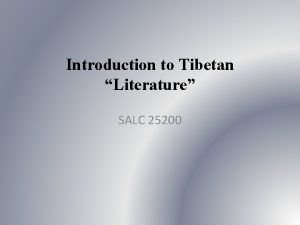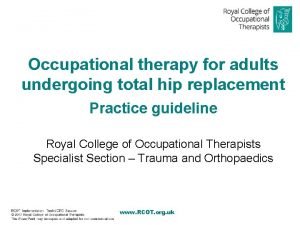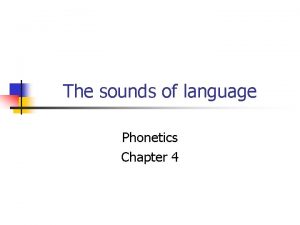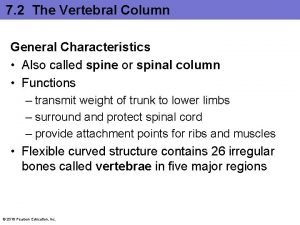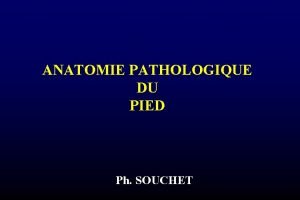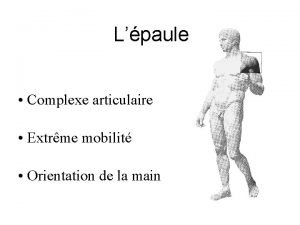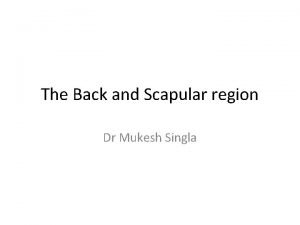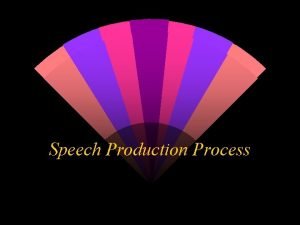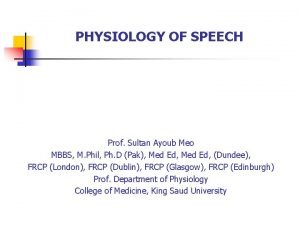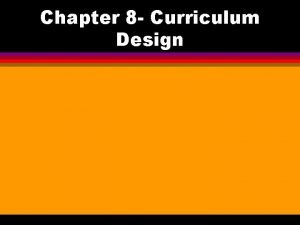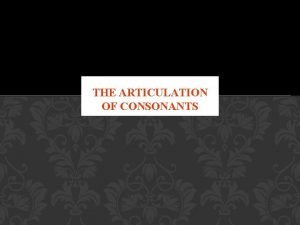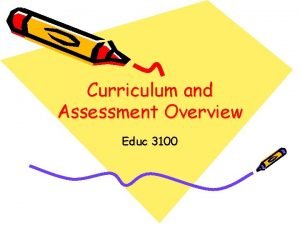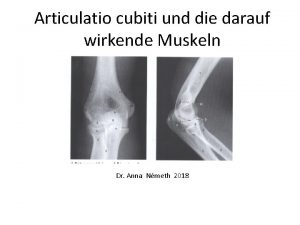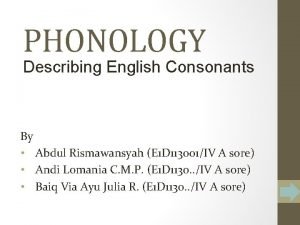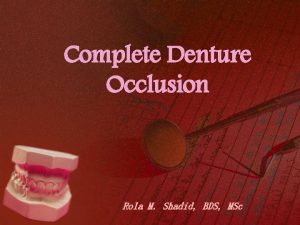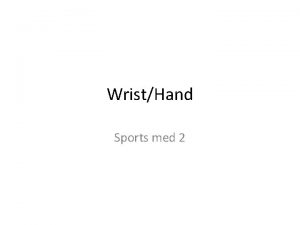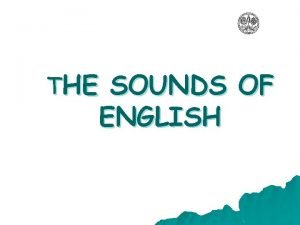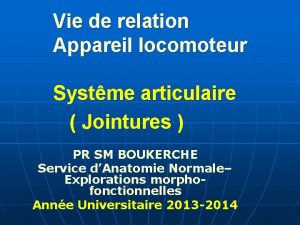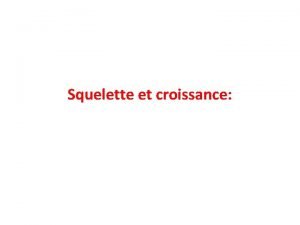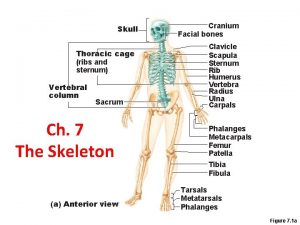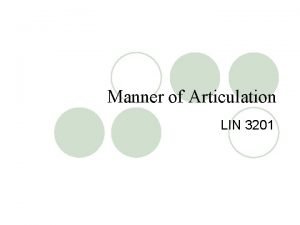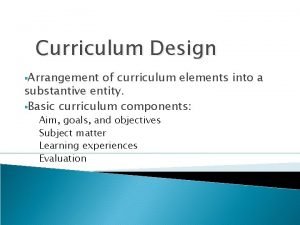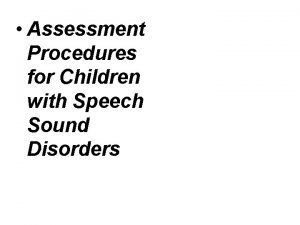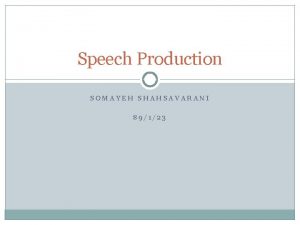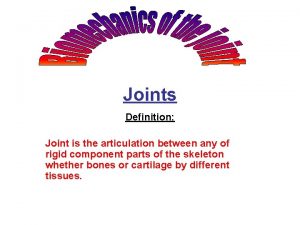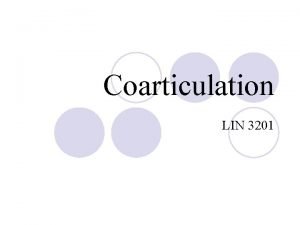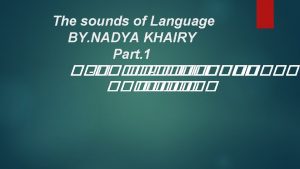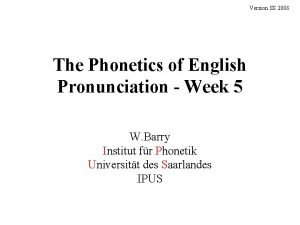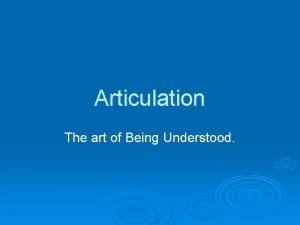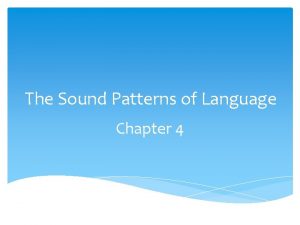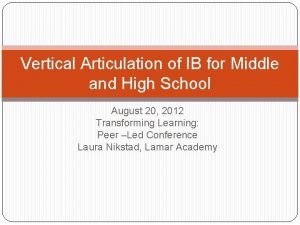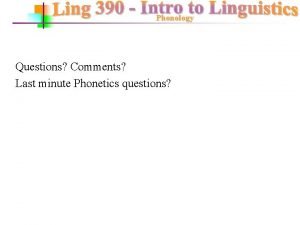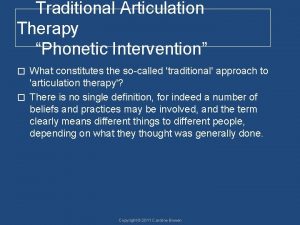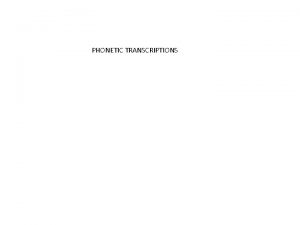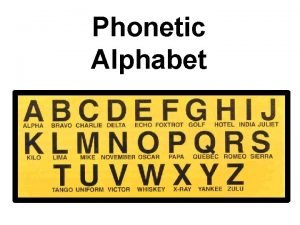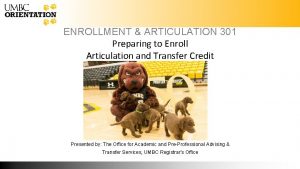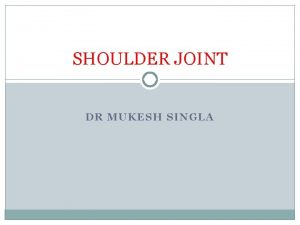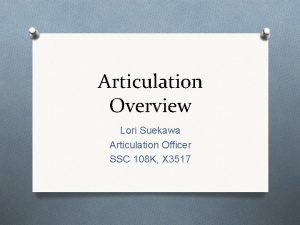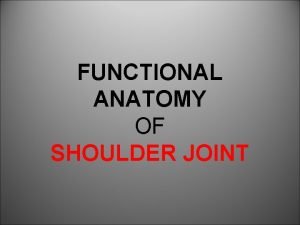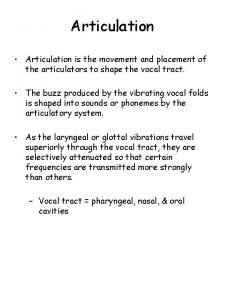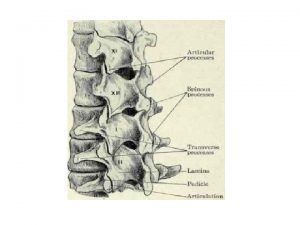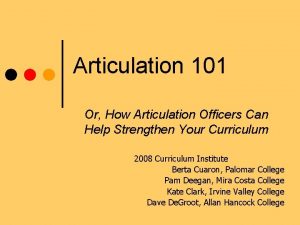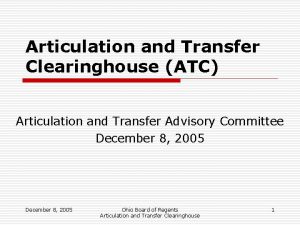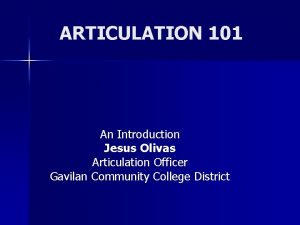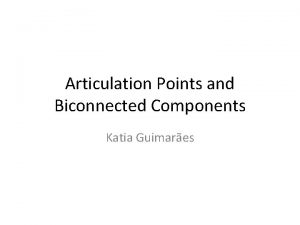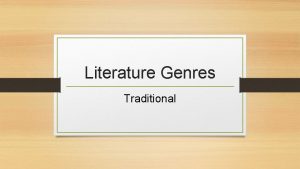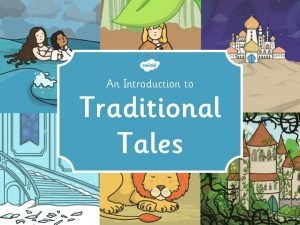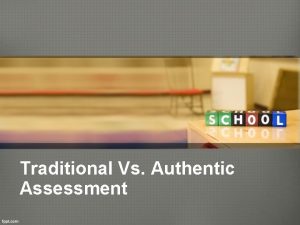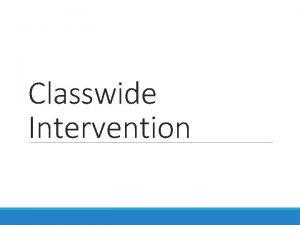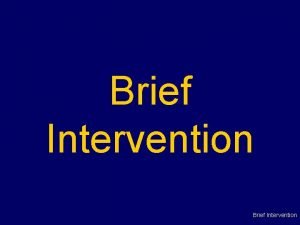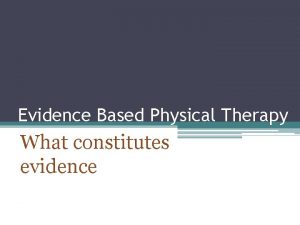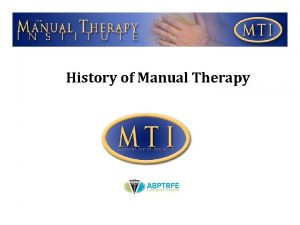Traditional Articulation Therapy Phonetic Intervention What constitutes the















































- Slides: 47

Traditional Articulation Therapy “Phonetic Intervention” What constitutes the so-called 'traditional' approach to 'articulation therapy'? � There is no single definition, for indeed a number of beliefs and practices may be involved, and the term clearly means different things to different people, depending on what they thought was generally done. � Copyright © 2011 Caroline Bowen

Procedures Some of the procedures that have characterised assessment and intervention for functional speech disorders, and which may be considered by many SLPs/SLTs to embrace 'traditional' approaches, were described by Powers (1971). � Powers maintained that the 'stimulus methods' developed and described by Travis (1931), had remained the core of the majority of treatment methodologies used by speech-language pathologists. � Powers began her therapy with auditory discrimination training. A sound was identified, named, discriminated from other speech sounds, and then discriminated in contexts of increasing complexity. � Copyright © 2011 Caroline Bowen

Hallmark sequence Permutations of the traditional approach, always putting discrimination of sounds produced by others first, are to be found in Berry and Eisenson (1956), Carrell (1968), Garrett (1973), Sloane and Macaulay (1968) and of course, Van Riper (1978 p. 179), who wrote: "The hallmark of traditional therapy lies in its sequence of activities for: (1) identifying the standard sound, (2) discriminating it from its error through scanning and comparing, (3) varying and correcting the various productions until it is produced correctly, and finally, (4) strengthening and stabilizing it in all contexts and speaking situations. " Therapy resources designed for the administration of traditional approaches to speech therapy for children's speech sound disorders continue to be published, some incorporating aspects of other programs and methodologies, and some with evidence of internal development. Copyright © 2011 Caroline Bowen

Therapist as teacher Adopting the role of teacher, therapist guides the child through a series of carefully sequenced and graded steps, usually one phoneme at a time. � The procedure starts with ear training, and goes on through increasingly complex production contexts. Finally the phoneme is used in spontaneous conversational speech, and the emphasis moves to self-monitoring. � The child takes a "passive learner" role, with active exploration and processing of the sound system not specifically encouraged. The approach, rather than being communication centred, is "therapy" centred, with the child learning what therapist sets out to teach. � Copyright © 2011 Caroline Bowen

Evidence Following the example of the medical profession, published evidence of the success of traditional approaches has been mainly in the form of case illustrations and clinical descriptions (for example, Powers, 1971; Travis, 1931; Van Riper & Irwin, 1959). Copyright © 2011 Caroline Bowen

“Regardless of their placement on the phonetic phonemic continuum, children with speech disorders require aspects of each in remediating their sound disorders. The focus on either the phonetic or phonemic aspects of sound production will vary depending upon the child’s learning needs. I believe that intervention that focuses on one aspect to the exclusion of the other will be limited in terms of longer intervention periods and/or in failure to generalize. ” Williams, 2005 Copyright © 2011 Caroline Bowen

Target Selection � Phonetic targets are sounds that the child is unable to produce or sounds for which the child does not have true stimulability. � Likely candidates are /s/ and other fricatives, the affricates, /r/, /l/, /ð/ and /θ/, including “residual errors”. Copyright © 2011 Caroline Bowen

Intervention Procedures Identify the standard sound. 2. Discriminate it from its error. 3. Vary and correct (“shape”) productions until it is produced correctly. 4. Strengthen and stabilise it in all contexts and speaking situations. Van Riper (1978, p. 179). 1. Copyright © 2011 Caroline Bowen

Intervention Activities Therapy incorporates � Phonetic placement � Auditory discrimination training � Drill-play The following slides contain examples of the types of activities and materials employed. Copyright © 2011 Caroline Bowen

Cue cards: pictures and sounds Say the speech sound not the letter name when providing cues. t May need to explain this repeatedly. The dripping tap says t t t The snake sound is s… s 26 October 2021

CUE CARDS Use imagery the child understands sh The “be quiet noise” is /ʃ/ The bunny rabbit noise is /f/ f 26 October 2021

There is no “right way” to cue – use imagery that “means something” to child and family. z A buzzy be goes /z/ The popcorn noise is p p

Picture and phoneme m ch Say /m/, not “em” or “muh” Say /ʧ/, not “cee aitch” or “chuh”

Word Flips (Granger, 2005) • Useful resource – CV words presented in a format that many children enjoy. Copyright © 2011 Caroline Bowen

Game Formats Posting toys, trains, photo cubes, necklaces, flash cards on key rings, brag books … 26 October 2021 Copyright © 2011 Caroline Bowen

CV Syllable and Word Drills C + /i: / (consonant plus “ee”) Copyright © 2011 Caroline Bowen 26 October 2021

CV Copyright © 2011 Caroline Bowen sea 26 October 2021

CV sigh Copyright © 2011 Caroline Bowen 26 October 2021

CV Copyright © 2011 Caroline Bowen sew 26 October 2021

CV Copyright © 2011 Caroline Bowen saw 26 October 2021

VC syllable and word drills V + stop (vowel plus p t k b d or g) Copyright © 2011 Caroline Bowen 26 October 2021

VC Copyright © 2011 Caroline Bowen up 26 October 2021

VC Copyright © 2011 Caroline Bowen ape 26 October 2021

VC Copyright © 2011 Caroline Bowen eat 26 October 2021

VC eight 8 Copyright © 2011 Caroline Bowen 26 October 2021

VC ark Copyright © 2011 Caroline Bowen 26 October 2021

VC ache Copyright © 2011 Caroline Bowen 26 October 2021

add VC 4+ 4= 8 Copyright © 2011 Caroline Bowen 26 October 2021

VC Copyright © 2011 Caroline Bowen odd 26 October 2021

VC Copyright © 2011 Caroline Bowen ugg 26 October 2021

VC Copyright © 2011 Caroline Bowen egg 26 October 2021

Single word production drill Game: Artic Chipper Chat Copyright © 2011 Caroline Bowen 26 October 2021

Single word production drill CD - Speech Sounds on Cue http: //www. mmsp. com. au Copyright © 2011 Caroline Bowen 26 October 2021

Single word production drill Smart Chute Copyright © 2011 Caroline Bowen

Single word and short phrase production drill sheep cape soup cup soap pipe rope top === sheep in a cap, sheep in a cape, sheep slurping soup, sheep with a cup… http: //www. blacksheeppress. co. uk Copyright © 2011 Caroline Bowen 26 October 2021

Single word and sentence production drill Lingui. Systems SPARC Revised, SPARC Artic Junior, SPARC for Phonology; SPARC R and S Copyright © 2011 Caroline Bowen 26 October 2021

Single word and sentence production drill Power Point Picture Sequences /k/ at the beginnings of words Copyright © 2011 Caroline Bowen 26 October 2021

key Mum lost her key. Copyright © 2011 Caroline Bowen 26 October 2021

cup Is that your cup? Copyright © 2011 Caroline Bowen 26 October 2021

cap Andrew has a cap. Copyright © 2011 Caroline Bowen 26 October 2021

cone I want an ice-cream cone. Copyright © 2011 Caroline Bowen 26 October 2021

walk Go for a walk. Copyright © 2011 Caroline Bowen 26 October 2021

sock That’s not my sock! Copyright © 2011 Caroline Bowen 26 October 2021

hook See the shiny hook. Copyright © 2011 Caroline Bowen 26 October 2021

work I like this work. Copyright © 2011 Caroline Bowen 26 October 2021

Apps http: //health. groups. yahoo. com/group/phonologicaltherapy/message /200 97 �i. Pad Apps �i. Speech for i. Pad �Artik. Pix �Pocket SLP �Phono. Pix �Articulate It (Smarty Ears) �Toontastic Copyright © 2011 Caroline Bowen Articulation

REFERENCES Berry, M. D. , & Eisenson, J. (1956). Speech disorders: Principals and practices of therapy. New York: Appleton Century Crofts. Carrell, A. A. (1968). Disorders of articulation. Englewood Cliffs, N. J. : Prentice Hall. Garrett, E. R. (1973). Programmed articulation therapy. In D. Wolfe & D. J. Golding (Eds. ). Articulation and learning. Springfield, Ill. : Charles C. Thomas. Powers, M. H. (1971). Clinical educational procedures in functional disorders of articulation. In L. E. Travis, (Ed. ). Handbook of speech pathology and audiology. Englewood Cliffs, N. J. : Prentice-Hall. Raz, M. G. (2009). One clinician's streamlining of traditional articulation therapy. In C. Bowen, Children's speech sound disorders. Oxford: Wiley-Blackwell, pp. 14 -17. Sloane, H. N. Jr. , & Macaulay, B. D. (Eds. ). (1968). Operant procedures in remedial speech and language training. Boston: Houghton Mifflin. Travis, L. E. (1931). Speech pathology. New York: Appleton. Van Riper, C. (1978). Speech correction: Principles and methods. (6 th ed. ). Englewood Cliffs, N. J. : Prentice-Hall. Van Riper, C. & Irwin, J. V. (1959). Voice and articulation. London: Pitman Medical Publishing Company. Copyright © 2011 Caroline Bowen
 Pugyel
Pugyel Occupational therapy intervention plan for hip arthroplasty
Occupational therapy intervention plan for hip arthroplasty Bioness bits cost
Bioness bits cost Humanistic therapy aims to
Humanistic therapy aims to Psychoanalytic vs humanistic
Psychoanalytic vs humanistic Major phonetic classes
Major phonetic classes Manner of articulation
Manner of articulation Figure 7-2 typical vertebra (inferior view)
Figure 7-2 typical vertebra (inferior view) Mediotarse
Mediotarse Rotation transversale
Rotation transversale Slidetodoc.com
Slidetodoc.com Speech production
Speech production Articulation mechanism
Articulation mechanism Condylar guidance and incisal guidance
Condylar guidance and incisal guidance Radical design curriculum
Radical design curriculum Diploe bone
Diploe bone Consonants place of articulation
Consonants place of articulation Michael bolling vdoe
Michael bolling vdoe Vertebre toracique
Vertebre toracique Vertical articulation example
Vertical articulation example Articulatio cubiti
Articulatio cubiti Manner of articulation
Manner of articulation Balanced occlusion
Balanced occlusion Articulation sports med
Articulation sports med Glide vowels
Glide vowels The organs of articulation
The organs of articulation Articulation sphéroide
Articulation sphéroide Double articulation
Double articulation Tubérosité naviculaire
Tubérosité naviculaire Xiphoid process
Xiphoid process Mode of articulation
Mode of articulation The arrangement of curriculum is known as
The arrangement of curriculum is known as Caap articulation test
Caap articulation test Phonation and articulation
Phonation and articulation Facettes costales
Facettes costales Organic occlusion definition
Organic occlusion definition Functions of joints
Functions of joints Coarticulation in phonetics
Coarticulation in phonetics Oacac articulation
Oacac articulation Language
Language Affricate
Affricate Manner of articulation
Manner of articulation Articulation letter writing
Articulation letter writing Coarticulation
Coarticulation Vertical articulation template
Vertical articulation template Phonological rule
Phonological rule Luxation spatulo columnaire
Luxation spatulo columnaire Double articulation
Double articulation
